Ask Ethan # 88: Where is the cosmic microwave background radiation?
This is the oldest and most distant light from us. But where exactly is it?
It was said that we let our light just shine, and then we will not need to tell everyone that it shines. Lighthouses do not shoot cannons in order to draw attention to their light - they just shine.
- Dwight L. Moody
If you look at the remote parts of the Universe, you will look into the past because the speed of light is finite, although it is very high. So, looking at the farthest object of the visible, the very first light perceived by our equipment, we have to achieve something. In the case of our Universe, as far as we know, this will be the residual glow of the Big Bang: cosmic microwave background radiation. All of you have sent a large number of questions, and this week I decided to answer the question of David English:
We see the popular image of CMI in the form of a globe. It surrounds us. As I understand it, KMFI is the earliest image of the Universe. As we look into the past, when we observe distant objects, the CMBR should be the farthest from all. This means that the CMBR is at the end of the Universe, but this is not so. The space is infinite, as far as we know, and we do not see its face. So where is KMFI, if not at the end of the Universe?
We will start with the Big Bang itself in order to come to KMFI.
')
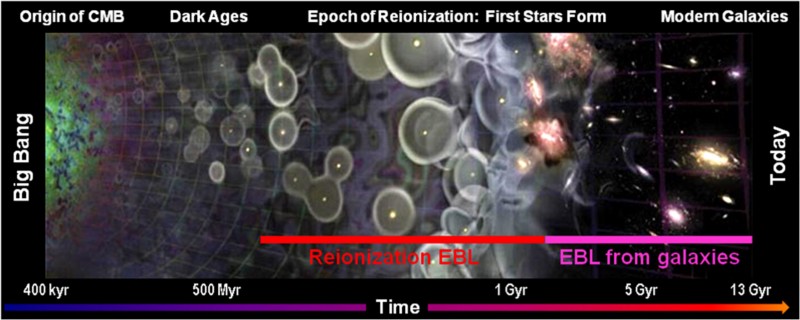
When the hot Big Bang began - after cosmic inflation, which lasted an indefinite period of time - the Universe had the following properties:
• She was big. Most likely, much more (at least hundreds of times) than the part we surveyed.
• It was very homogeneous — with the same energy density — on average for 1 part out of 10,000.
• She was very hot. The energy was at least 10,000,000 times more than the largest levels attainable at the Large Hadron Collider.
• It was also dense. The densities of radiation, matter and antimatter were trillions trillion times greater than that of the uranium nucleus.
• And it also expanded and cooled very quickly.
This is where we started. This is our past 13.8 billion years ago.

But with expansion and cooling, several amazing things happened in our cosmic history, everywhere at the same time. Unstable matter / antimatter pairs annihilated when the Universe cooled below the temperature threshold necessary for their spontaneous appearance. As a result, we are left with a small amount of matter, which somehow began to prevail over antimatter.

With a decrease in temperature, nuclear fusion between protons and neutrons began to occur, which led to the appearance of heavier elements. And although a lot of time - from 3 to 4 minutes (and in the early Universe is a whole life) - was spent on the formation of deuterium, the first step (deuteron is one proton and one neutron) in all nuclear reactions, from this moment we have a large amount of helium and hydrogen, as well as a small amount of lithium.
The first elements of the Universe were formed here, in a sea of neutrons, photons and ionized electrons.
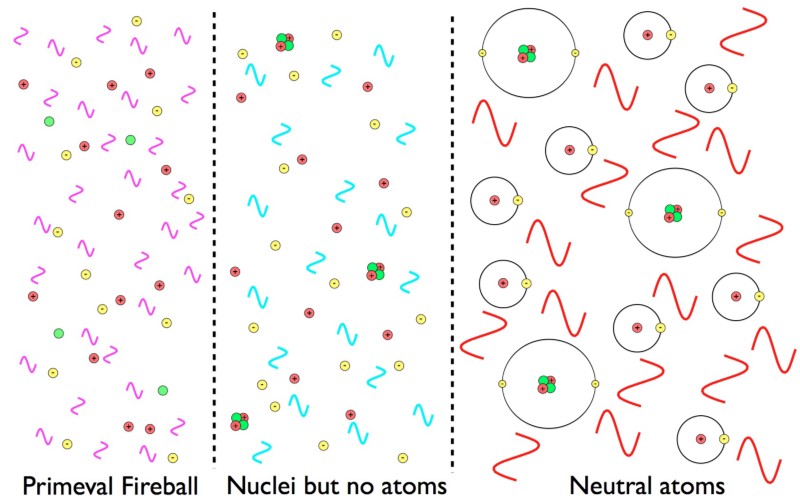
Energy of the order of several MeV is required for the synthesis of heavy elements from light ones, but if you need to form neutral atoms, it is necessary that the energy fall to several eV - about a million times.
The formation of neutral atoms is very important in order to be able to see what is happening. Because, regardless of the amount of light available, if huge dense herds of electrons floating around are hindering it, this light will be scattered on them according to a process known as Thomson scattering (and for high energies, Compton).
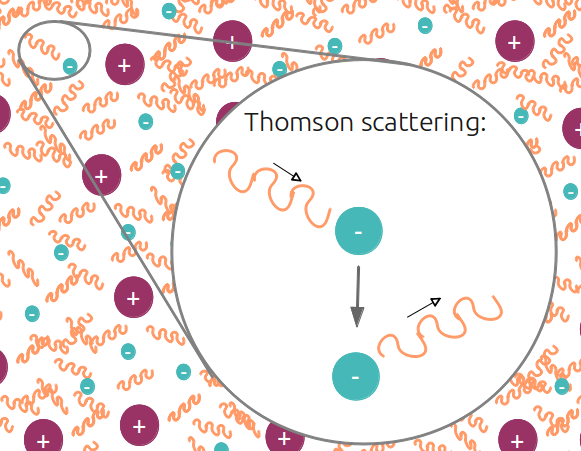
And as long as you have a sufficiently high density of free electrons, all this light, almost without dependence on energy, will be reflected and scattered, exchange energy and destroy any information in collisions (or rather, randomize). Until neutral atoms appear that will trap electrons so that photons can travel freely, nothing can be “seen” (at least not by light).
It turns out that for this the Universe needs to be cooled to a temperature of 3000 K. The photons are much larger than electrons (about a billion times), so you need to reach such an "ultra-low" temperature so that the most high-energy of the photons are those that have energy for ionization. hydrogen - fall below this bar of critical energy. By that time, the universe had already arrived 380,000 years, and the process itself lasted about 100,000 years.
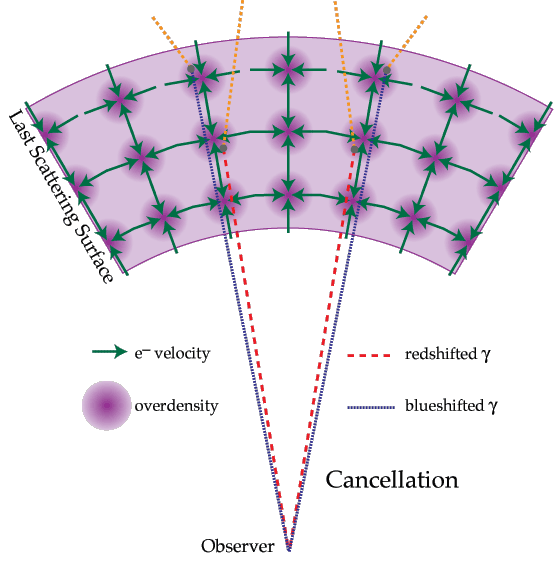
This happens everywhere at the same time, gradually, and at the end of the process, all the light of the Universe finally gets the opportunity to fly out in all directions at the speed of light. KMFI was emitted when the Universe was 380,000 years old, and at the time of emission it was not “microwave” light: it was infrared, with some portions of such a high temperature that it could be seen with the human eye if there was someone to watch on him.
We have enough evidence that the temperature of KMFI was higher in the past; climbing in the region of an increasingly strong redshift, we observe just that.
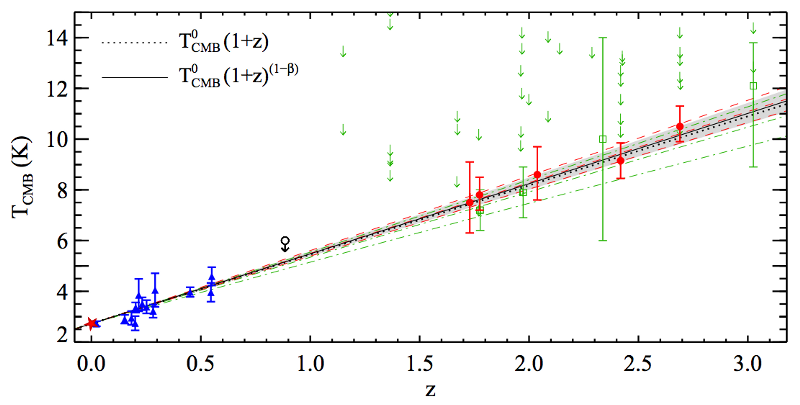
Extrapolation into the past of what we see today - a background of 2.725 K emitted with an offset of z = 1089, shows that at the moment of emission of the CMPI, it had a temperature of 2940 K. The CMYF is not the edge of the Universe, but the “edge” of what we can see.
When we look at KMFI, we find fluctuations in it: areas of high density (more “blue” or cold) and low (more “red” or hot), representing slight deviations from perfect homogeneity.

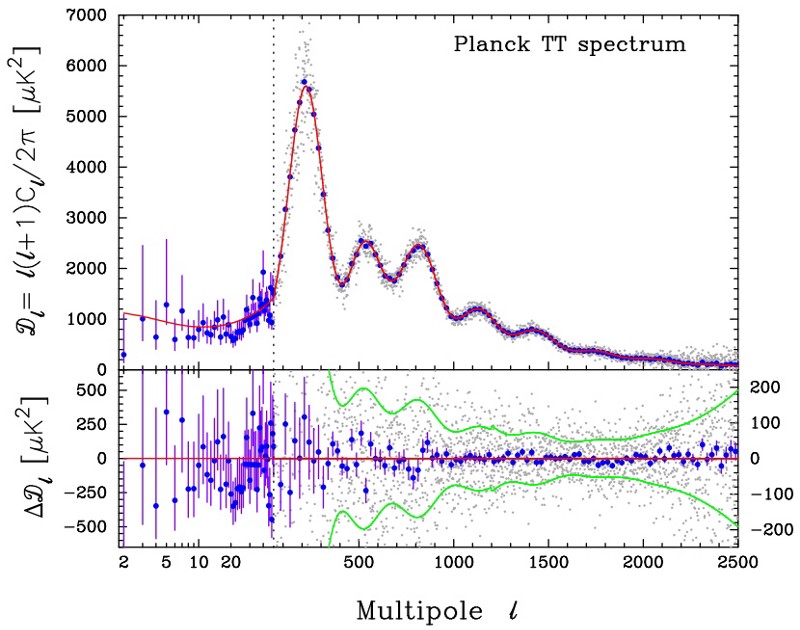
This is good for two reasons:
1. These fluctuations were predicted by inflation, and their independence of scale was predicted. It was in the 1980s; observations and confirmations of these fluctuations using satellites in the 90s (COBE), 00s (WMAP) and 10s (Planck) confirmed the theory of inflation.
2. These fluctuations, with the appearance of regions of density above and below the average, are necessary for the emergence of large-scale structures — stars, galaxies, groups, clusters, and filaments — separated by huge cosmic voids.
Without these fluctuations, we would not have such a universe.
And nevertheless, although the light from KMFI originates from the moment when the Universe was 380,000 years old, the light we observe on Earth is constantly changing. You see, the universe is about 13.8 billion years old, and although dinosaurs - if they built microwave radio telescopes - could watch CMI in their own right, it would be a little different.

It would have been hotter for several millikelvins, since several hundred million years ago the universe was younger, but, more importantly, the pattern of fluctuations would be very different from today. Not statistically: the total value or spectrum of hot or cold areas would be about the same (within the boundaries of the cosmic changes) as they are today. But the fact that today is hot or cold would hardly be related to the fact that it would be hot or cold one or two hundred thousand years ago, and even more so, a hundred million.
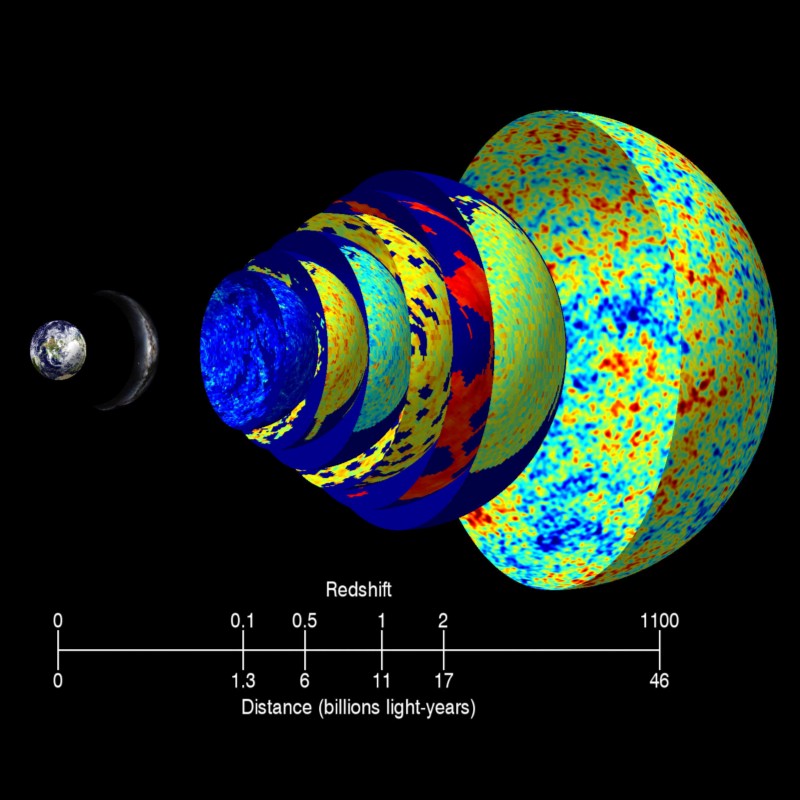
When we look at the Universe, the KMFI is present everywhere, in all directions. It exists for all observers at all points, and is constantly emitted in all directions from a source that is observed as the “last scatter surface”. If we wait long enough, we will see not just a photo of the Universe in infancy, but a whole film that would allow us to map more and less dense regions in three dimensions over time! In theory, we can extrapolate this into the future, as microwave radiation goes into the radio spectrum when the photon density falls from 411 per cubic centimeter to tens, to units, and even to millionths of the current density. Radiation is not going anywhere, as long as we can build sufficiently large and sensitive telescopes to detect it.
So, the KMFI is not the end of the Universe, but the boundary of what we can see, both by distance (how far we go) and by time (how far into the past we look). Theoretically, there is hope that we can get even further into the past.

Although the light is limited to the age of 380,000 years, neutrinos and antineutrinos created during the Big Bang traveled freely and practically without restrictions from the time the Universe turned out from one to three seconds! If we can build a detector sensitive enough to measure and map the cosmic neutrino background (CNF), we can look back even further: many times closer to the beginning of the hot Big Bang. These energies are very small — a few hundred µeV — but they must exist. They are just waiting for us to figure out how to find them.
So, David, we see not the edge of the universe, and not even the most distant thing available. This is only - taking into account the limitations of our technologies and knowledge - the furthest thing that we can see today. And she is constantly moving away. As the universe ages, we look deeper and deeper into the past. As Matthew McConachy once said, “I’m getting old, and they stay the same age.”

It is the same with the Universe: we are aging, but the CMBI remains the same age.
Thank you for the wonderful question, and I hope you enjoyed looking into the past. Send me your questions and suggestions for the following articles.
Source: https://habr.com/ru/post/397263/
All Articles